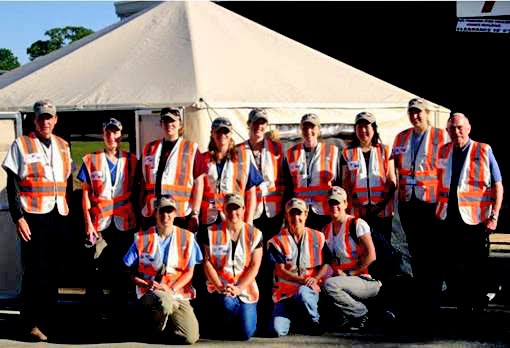It's not exactly like M*A*S*H, but if you squint there's definitely a similarity.

A new team of Texas rangers has been formed that stands ready to serve the state's citizens during times of emergency. Like their famous counterparts of the past they also work on the wide open range – as well as in stalls, coops, pens, barns, and drylots.
These are the new Texas V.E.T. rangers. The initials stand for Veterinary Emergency Team, and as the name implies it has been created by the Texas Animal Health Commission (TAHC) and the Texas A&M University (TAMU) College of Veterinary Medicine and Biomedical Sciences to respond to statewide animal medical disasters if, when, and where they occur.
The 13-member team (pictured above), consisting of TAMU faculty, resident veterinarians, veterinary technicians, and select veterinary students, is deployable under the state's animal response plan in any disaster situation that has a need for additional veterinary assessment, triage and care. It is fully self-sufficient in lodging, food, generators and supplies for responders. Its equipment includes two large climate-controlled tents, one multi-purpose trailer, and one clinic trailer with limited surgical capability. It also has obtained trucks to haul trailers and equipment, as well as an ambulatory medicine truck.
Team members are divided into strike teams that can be targeted at either large or small animal issues, and are capable of dealing with animals and poultry of all kind, including exotic species.
Under the state's animal response plan, the V.E.T. team will deploy with TAHC field personnel during a large-scale disaster and work under the same incident command structure. The team's first field exercise was held in College Station in April, and it will be fully operational and mission-ready in time for the 2010 hurricane season.
"Our two organizations have put together an impressive array of equipment and personnel that will have the ability to limit and prevent animal suffering as disasters occur," said Dr. Wesley Bissett, TAMU's lead faculty member in the V.E.T. effort. "In addition, TAHC has provided us the opportunity to increase our efforts in teaching emergency response in the veterinary medical curriculum. Ultimately, this will lead to increased numbers of veterinarians committed to and trained in emergency response."


A new team of Texas rangers has been formed that stands ready to serve the state's citizens during times of emergency. Like their famous counterparts of the past they also work on the wide open range – as well as in stalls, coops, pens, barns, and drylots.
These are the new Texas V.E.T. rangers. The initials stand for Veterinary Emergency Team, and as the name implies it has been created by the Texas Animal Health Commission (TAHC) and the Texas A&M University (TAMU) College of Veterinary Medicine and Biomedical Sciences to respond to statewide animal medical disasters if, when, and where they occur.
The 13-member team (pictured above), consisting of TAMU faculty, resident veterinarians, veterinary technicians, and select veterinary students, is deployable under the state's animal response plan in any disaster situation that has a need for additional veterinary assessment, triage and care. It is fully self-sufficient in lodging, food, generators and supplies for responders. Its equipment includes two large climate-controlled tents, one multi-purpose trailer, and one clinic trailer with limited surgical capability. It also has obtained trucks to haul trailers and equipment, as well as an ambulatory medicine truck.
Team members are divided into strike teams that can be targeted at either large or small animal issues, and are capable of dealing with animals and poultry of all kind, including exotic species.
Under the state's animal response plan, the V.E.T. team will deploy with TAHC field personnel during a large-scale disaster and work under the same incident command structure. The team's first field exercise was held in College Station in April, and it will be fully operational and mission-ready in time for the 2010 hurricane season.
"Our two organizations have put together an impressive array of equipment and personnel that will have the ability to limit and prevent animal suffering as disasters occur," said Dr. Wesley Bissett, TAMU's lead faculty member in the V.E.T. effort. "In addition, TAHC has provided us the opportunity to increase our efforts in teaching emergency response in the veterinary medical curriculum. Ultimately, this will lead to increased numbers of veterinarians committed to and trained in emergency response."










